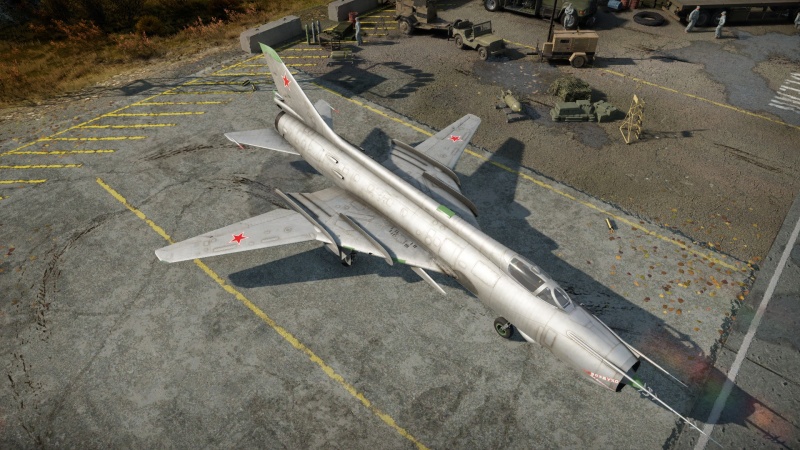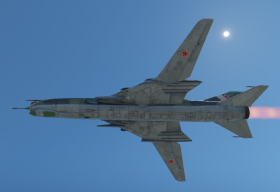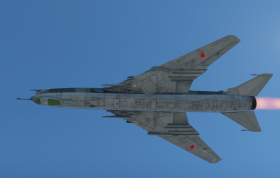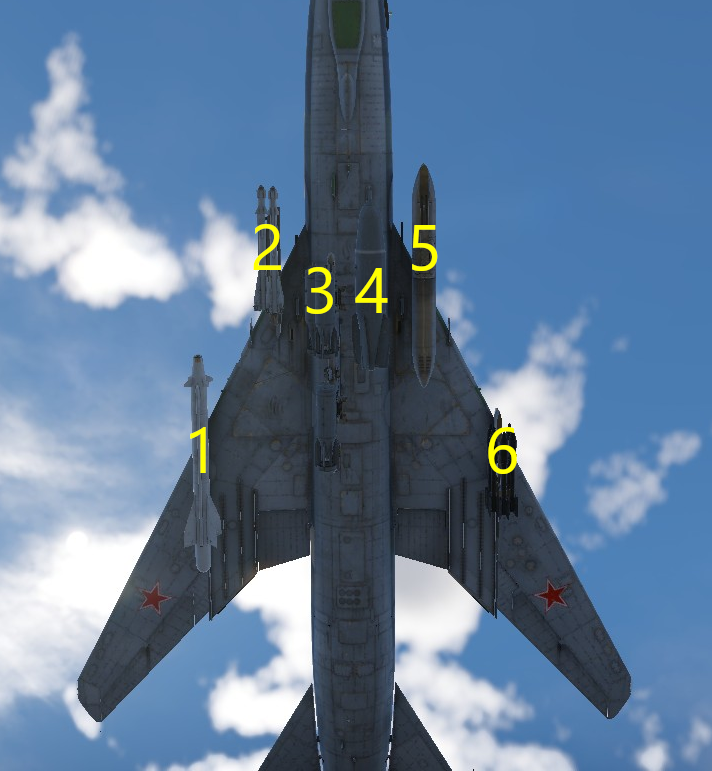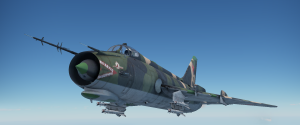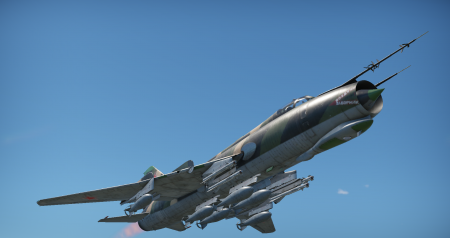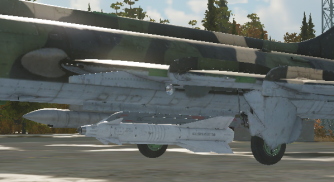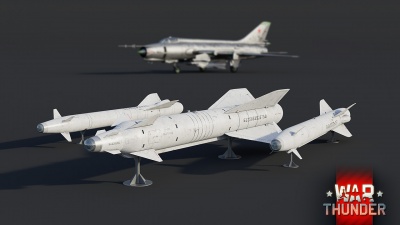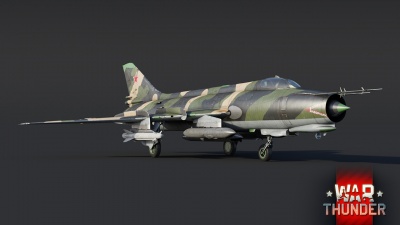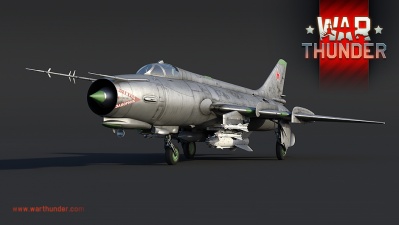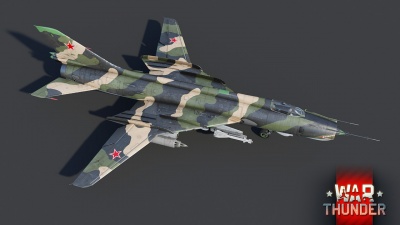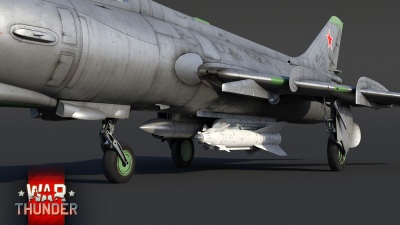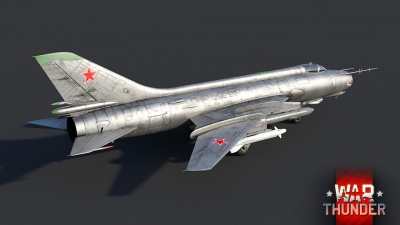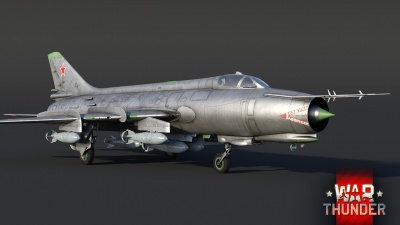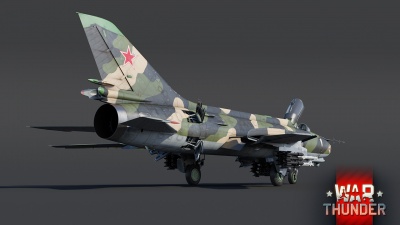Difference between revisions of "Su-17M2"
(→Description) |
m (→See also: I added the list with links to other aircraft with variable geometry wings that exist in the game) (Tag: Visual edit) |
||
| (One intermediate revision by one other user not shown) | |||
| Line 214: | Line 214: | ||
| || || 1<sup>†</sup> || || || | | || || 1<sup>†</sup> || || || | ||
|- | |- | ||
| − | ! | + | ! 820 l drop tanks |
| − | | || || 1 || 1 || || | + | | 1 || || 1 || 1 || || 1 |
|- | |- | ||
| colspan="8" | * The Delta-NG targeting pod must be carried when equipping Kh-23M missiles <br> <sup>†</sup> The Projector-1 pod and Kh-29L missile must be equipped together | | colspan="8" | * The Delta-NG targeting pod must be carried when equipping Kh-23M missiles <br> <sup>†</sup> The Projector-1 pod and Kh-29L missile must be equipped together | ||
| Line 224: | Line 224: | ||
{{Navigation-First-Simple-Line}} | {{Navigation-First-Simple-Line}} | ||
| − | * | + | * 4 x 820 l drop tanks |
* 2 x R-60 missiles | * 2 x R-60 missiles | ||
* 4 x R-60 missiles | * 4 x R-60 missiles | ||
| Line 358: | Line 358: | ||
* [[Su-7BKL]] | * [[Su-7BKL]] | ||
* [[Su-7B]] | * [[Su-7B]] | ||
| − | * [[Su- | + | * [[Su-17/22 (Family)]] |
| − | |||
;Aircraft of a similar role, configuration or era | ;Aircraft of a similar role, configuration or era | ||
| Line 366: | Line 365: | ||
* [[A-7D|A-7D Corsair II]] | * [[A-7D|A-7D Corsair II]] | ||
* [[F-4C Phantom II]] | * [[F-4C Phantom II]] | ||
| + | |||
| + | ; '''Other jet planes with variable sweep wings''' | ||
| + | |||
| + | * [[Tornado (Family)]] | ||
| + | * [[MiG-23 (Family)]] | ||
| + | * [[F-14 (Family)|F14 (Family)]] | ||
| + | * [[F-111A]] | ||
== External links == | == External links == | ||
Latest revision as of 03:54, 24 March 2024
| This page is about the Soviet strike aircraft Su-17M2. For other versions, see Su-17/22 (Family). |
Contents
Description
Almost immediately after the Su-7 fighter-bomber was accepted into service in 1959, a directorate was issued to vastly upgrade the aircraft, as technology of the '50s and '60s was rapidly advancing and leaving the Su-7 behind. Throughout the early '60s, many avionics and ordnance upgrades were experimented with, but the largest change would not come from the Soviets, but rather, the Americans. In 1964, the culmination of the USAF's TFX program, the F-111 "Aardvark", performed its first flight, and presented to the world the dynamics of variable-geometry wings. The Soviets, as not to be out-done, hammered a partially variable geometry wing (only the outer half of the wing could pivot) into their updated Su-7 prototype, and redubbed it the Su-17. This new aircraft would first fly only two years later, in 1966, and would enter service as the Su-17M shortly after, with a export variant named the Su-20. The Su-17 and its derivatives would serve a long life with many operators around the world, from the oriental shores of Vietnam to the mountainous reaches of Peru in South America. Throughout its long life, the Su-17 would be upgraded into many variants, starting with the Su-17M2, and eventually evolving into the Su-17M3 and M4, marketed respectively as the Su-22M3 and M4 for export. Even the Russian Federation would continue to use its later variants after the collapse of the USSR, and the Fitter family still finds use with third world countries to this day, even garnering short-lived fame in recent times in 2017 when a Syrian Su-22M4 defeated the latest AIM-9X fired from a USN F/A-18E Super Hornet in a well documented incident resulting in the last aircraft in recent times shot down by the United States.
The Su-17M2 was introduced in Update "Ixwa Strike" as the first aircraft with variable-geometry wing ("swing wing") mechanics in-game. While underwhelming compared to not only its adversaries, but also its own contemporaries in its own tech tree, the aircraft lays the foundation of skill required to operate other, more advanced swing-wing attack aircraft in the Soviet tech tree, such as the later Su-17M4 and the MiG-27s. Being the first supersonic aircraft with laser guided ordnance in the Soviet tech tree, this aircraft builds on doctrine established from both the slower, more cumbersome Su-25s and the fast and hard-hitting Su-7s, making this plane a stepping stone towards the later Soviet supersonic fighter-bombers.
General info
Flight performance
The Su-17M2 has extremely competitive flight characteristics given by its variable sweep wings, which can change from an angle of 30 degrees swept forward to 63 degrees when fully swept back. Firstly, the Su-17 is fast. This aircraft can reach a top speed of ~1,440 km/h TAS on the deck (or 1,420 km/h IAS), meaning that it can easily outrun Phantoms, MiG-21s, and other comparable top-tier aircraft. The only two exceptions to this are the Italian F-104S Starfighter and British Phantoms (FGR.2 and FG.1), which can outrun the Su-17 at sea level by a small margin. The aircraft's acceleration is very competitive below speeds of 1,100 km/h, but does take more time to accelerate above that speed. Note that acceleration at high speeds improves dramatically when the wings are swept fully backwards.
In terms of overall agility, the Su-17M2 is quite manoeuvrable, though this performance is greatly affected by wing sweep and speed. When the wings are swept backwards, the aircraft handles very similarly to the prior Su-7B. However, when the wings are swept forward, you will see a dramatic improvement in turn performance - in fact, the Su-17 can out-turn Phantoms when wings are fully swept forwards. The sustained horizontal turn rate peaks at 17°/s between 650-750 km/h IAS when it carries missiles with automatic wing sweep controls, which is better than any F-4, MiG-21 and most of other dedicated jet fighters. In fully swept forward configuration it further increases to 19 °/s in sustained turning above 700 km/h IAS .The Su-17's turn rate decreases a lot at low speed below 500 km/h IAS and its instantaneous turn rate is mediocre at best. The aircraft features an all-flying tail making elevator performance quite adequate. The aircraft's roll rate is worse compared to other jet fighters like the MiG-21 or F-4, with the automatic sweep wing control it reaches 90°/s at 600 km/h IAS and increases to 105°/s at 900 km/h IAS.
Structurally, the aircraft's wings rip at 1419 km/h IAS when fully swept back, a speed that the aircraft can attain easily at sea level. However, this speed limit depends on the wing angle and is reduced to just 1,050 km/h IAS with wings swept forwards.
| Characteristics | Max Speed (km/h at 11,000 m) |
Max altitude (metres) |
Turn time (seconds) |
Rate of climb (metres/second) |
Take-off run (metres) | |||
|---|---|---|---|---|---|---|---|---|
| AB | RB | AB | RB | AB | RB | |||
| Stock | 2,208 | 2,191 | 27.3 | 27.5 | 167.5 | 160.7 | 850 | |
| Upgraded | 2,252 | 2,232 | 26.7 | 27.0 | 214.5 | 190.0 | ||
Details
| Features | |||||
|---|---|---|---|---|---|
| Combat flaps | Take-off flaps | Landing flaps | Air brakes | Arrestor gear | Drogue chute |
| X | ✓ | ✓ | ✓ | X | ✓ |
| Limits | Wings (km/h) | Gear (km/h) | Flaps (km/h) | Max Static G | |||
|---|---|---|---|---|---|---|---|
| Combat | Take-off | Landing | + | - | |||
| Min sweep | 1,050 | N/A | 476 | 473 | ~10 | ~3 | |
| Max sweep | 1,417 | N/A | N/A | N/A | ~11 | ~4 | |
| Optimal velocities (km/h) | |||
|---|---|---|---|
| Ailerons | Rudder | Elevators | Radiator |
| < 740 | < 650 | < 650 | N/A |
Engine performance
| Engine | Aircraft mass | ||||||
|---|---|---|---|---|---|---|---|
| Engine name | Number | Basic mass | Wing loading (full fuel) | ||||
| Saturn AL-21F-3 | 1 | 11,050 kg | 386 - 430 kg/m2 | ||||
| Engine characteristics | Mass with fuel (no weapons load) | Max Gross Weight | |||||
| Weight (each) | Type | 12m fuel | 20m fuel | 30m fuel | 40m fuel | ||
| 1,800 kg | Afterburning axial-flow turbojet | 12,190 kg | 12,907 kg | 13,836 kg | 14,850 kg | 18,925 kg | |
| Maximum engine thrust @ 0 m (RB/SB) | Thrust to weight ratio @ 0 m (WEP) | ||||||
| Condition | 100% | WEP | 12m fuel | 20m fuel | 30m fuel | 40m fuel | MGW |
| Stationary | 6,400 kgf | 9,039 kgf | 0.74 | 0.70 | 0.65 | 0.61 | 0.48 |
| Optimal | 7,232 kgf (1,200 km/h) |
13,179 kgf (1,400 km/h) |
1.08 | 1.02 | 0.95 | 0.89 | 0.70 |
Survivability and armour
The Su-17M2 is quite survivable for a top-tier jet. Armour protects the pilot, with a 36 mm aluminium armour plating on the sides and back, as well as a 20 mm plate behind the headrest. The forward canopy features 25 mm of armoured glass, as well as a thin 8 mm steel plate in front of the controls. The large engine is mounted at the rear of the fuselage, while fuel tanks are mounted underneath it, as well as in the inner parts of the swept wing surfaces. Two sets of structural spars run the entire length of the wing, though only the forward set of spars are completely linked to each other.
The Su-17M2 is surprisingly easy to fly even with serious damage - the aircraft can safely make it back to the airfield even with a wing missing, due to the powerful ailerons. However, note that any damage to the wing surfaces can cause a large imbalance in lift, making turning difficult.
Modifications and economy
Armaments
| Ballistic Computer | |||
|---|---|---|---|
| CCIP (Guns) | CCIP (Rockets) | CCIP (Bombs) | CCRP (Bombs) |
| |
|
|
|
Offensive armament
The Su-17M2 is armed with:
- 2 x 30 mm NR-30 cannons, wing-mounted (80 rpg = 160 total)
Suspended armament
The Su-17M2 can be outfitted with the following ordnance:
| 1 | 2 | 3 | 4 | 5 | 6 | ||
|---|---|---|---|---|---|---|---|
| 23 mm GSh-23L cannons (250 rpg) | 1 | 1 | |||||
| 100 kg OFAB-100 bombs | 5 | 1 | 4 | 4 | 1 | 5 | |
| 250 kg OFAB-250sv bombs | 1 | 1 | 3 | 3 | 1 | 1 | |
| 250 kg OFAB-250Sh bombs | 1 | 1 | 3 | 3 | 1 | 1 | |
| 500 kg FAB-500M-62 bombs | 1 | 1 | 2 | 2 | 1 | 1 | |
| 500 kg FAB-500Sh bombs | 1 | 1 | 2 | 2 | 1 | 1 | |
| ZB-500 incendiary bombs | 1 | 1 | 1 | 1 | |||
| S-3K rockets | 7 | 7 | 7 | 7 | |||
| S-5K rockets | 32 | 32 | 32 | 32 | |||
| S-8KO rockets | 20 | 20 | 20 | 20 | |||
| S-24B rockets | 1 | 1 | 1 | 1 | 1 | 1 | |
| Kh-23M missiles | 1* | 1* | |||||
| Kh-25 missiles | 1 | 1 | |||||
| Kh-29L missiles | 1† | ||||||
| R-60 missiles | 1, 2 | 1, 2 | |||||
| Delta-NG targeting pod | 1* | ||||||
| Projector-1 targeting pod | 1† | ||||||
| 820 l drop tanks | 1 | 1 | 1 | 1 | |||
| * The Delta-NG targeting pod must be carried when equipping Kh-23M missiles † The Projector-1 pod and Kh-29L missile must be equipped together | |||||||
| Default weapon presets | |
|---|---|
| |
Usage in battles
The Su-17M2 is an extremely versatile aircraft due to its excellent flight performance and large variety of suspended payload options. As a result, a multitude of playstyles can be used. The Su-17M2 can be used as a support fighter, flanking and making full use of its powerful R-60 missiles, but can also be used as a bomber and CAS aircraft, in both Air and Ground RB.
- As a fighter
The Su-17M2 works quite well as a fighter, as it is fairly manoeuvrable and can be equipped with 4 x R-60 missiles which are extremely agile and track very well. In this role, it has two major advantages - speed and manoeuvrability. It can outrun everything except for the Italian F-104S Starfighter and British Phantoms when its wings are swept. It can out-turn everything except for the Mirage IIIC / IIIE and J35D Draken when its wings are extended, unless the Su-17 is close to its optimal speed at the start of the engagement and the enemy player forces them into a longer horizontal turn fight. In this regard, the aircraft works best in a support / boom & zoom role. At the start of each battle, climb a bit (but not over 3 km because you will be Phantom food) to the side of the map. Once most enemies have been spotted, turn into the battlefield and utilize Boom & Zoom manoeuvres. Target enemies that are slow or not paying attention. If you are behind multiple enemies, target the lowest enemy first, so that you are below the rest of the aircraft. This ensures that you remain on the blind spot of the rest of the aircraft.
It is not recommended to engage in extended dogfights. Though you may win a single dogfight, it will leave you slow and vulnerable to a follow-up missile attack from an enemy, which you will not be able to dodge. Only dogfight if you have teammate support, and there are no other enemies in the area. Your 30 mm NR-30 cannons are extremely capable of destroying enemy aircraft, especially using the Air Targets belt, which can usually confirm a kill with only a few hits, if not one or two.
- As a bomber or fighter-bomber
The Su-17M2 can be used as a bomber, particularly when you haven't unlocked the R-60 missiles. The aircraft can carry loads of 20 x 100 kg bombs, 10 x 250 kg bombs or 8 x 500 kg bombs. The 100 kg bombs can take out a single mini-base (found on all maps with three bases) or a single large base (found on Ruhr and any four-base map), requiring you to drop all ordnance. The 250 kg bombs can take out two larger bases (5 per base) but are insufficient for a large base, meaning that the 100 kg bombs are better in this regard. The 500 kg bombs are the best option, being capable of destroying two+ mini-bases (3 per base) or two large bases (4 per base). When you bomb, make use of the Su-17M2's ballistic computer, which will give you an aiming reticle (similar to AB bombing) which displays your bomb's impact point. Simply nose down to a -10 degree dive or more and the reticle will appear.
However, when you are bombing, it is critical to maintain situational awareness. Before you bomb, plan out the flight path that you will take to return to base, because otherwise, you will be clubbed by a large group of angry enemy fighters. If the base you are bombing is far within enemy lines, flank and fly to the side of the map before commencing your attack. Do not rush straight for the base, especially if the base is deep within enemy lines, because you will< be shredded. After you complete your attack, return to base and reload.
Su-17M2 can most more effective when used as a fighter-bomber or multirole aircraft. This role allows you to get a high RP reward by bombing bases, and then contributing to your team by serving as a fighter. In this regard, the 6 x 500 kg bomb + 4 x R-60 missile loadout is the most effective. Bomb 1-2 bases (depending on map), then fly towards friendly lines, before beginning B & Z style fighter attacks.
- As a Close Air Support (CAS) aircraft
Finally, the Su-17M2 can be used as a CAS aircraft, particularly in mixed battles (Ground RB). In this regard, the aircraft excels due to its massive ordnance options. The aircraft's loadout of unguided bombs and rockets should come as no surprise to anyone who's played the Su-7B / BKL aircraft. Of these weapon types, the 500 kg unguided bombs can be extremely effective due to the large number of bombs carried - these weapons can be deadly when combined with the ballistic computer. As well, the aircraft can carry S-5K, S-3K and S-8KO rockets, along with the massive S-24 "Tiny Ivans". These weapons are all quite effective against enemy armour.
However, the aircraft does get access to some highly unique munitions, being the Kh-23M, Kh-25 and Kh-29L AGMs. The Kh-23M can be considered as an equivalent to the AGM-12B Bullpup, with a similar MCLOS guidance system and explosive mass, and can also be found on the Yak-38. However, the other two missiles are unique to this aircraft only. The Kh-25 is a laser-guided version of the Kh-23M with a larger warhead - this means that you can steer the missile using your mouse. Make sure to turn on the ground missile lock using spacebar or a custom keybind, then fire the missile and guide it by mouse. The Kh-29L is very similar, but features a massive 150 kg warhead with 103 mm of penetration. Note that enemy tanks with laser warning systems will be able to detect the launch of a Kh-25 or Kh-29L missile. As well, the main drawback of these weapons are the amount carried - the Su-17M2 can only carry a single Kh-29L or two Kh-25s. Thus, unguided bombs can often be more effective at destroying enemy vehicles.
- Enemies worth noting:
- The Mirage IIIC and the J35D: These planes are also serious foes as they out turn everything at their BR (keep in mind that the Draken is more manoeuvrable than the Mirage) so dogfighting them is a death sentence. They're also able to wield deadly missiles, the Draken wields the Swedish license built AIM-9P3s known as RB24Js and the Mirage has access to the extremely effective Matra R550 Magic 1 that pulls 30 Gs and has a higher top speed than other IR guided missiles. The best thing to do against these planes is to do a zoom climb to bleed their speed since they have a lower thrust to weight ratio than you and then do oblique turns since they both bleed a ton of speed when turning and have a lower acceleration than you do. Try to not let them shoot a missile at you since you don't have flares and will have to try to outturn it. If that happens turn off the afterburner and pull hard.
- Phantoms: These planes are the most common enemies and high-priority targets due to their extremely good missile armament and speed. This applies especially to the British Phantoms, which are capable of outrunning you by a small margin on the deck. However, you can out-turn them by a small margin with wings swept forwards. In many cases you can evade their AIM-9s by turning in one direction first, than rolling and switching direction. If you try to turn fight them, pull out your airbrakes to go below 1,000 km/h (620 mph), fold out the wings and you won't have any problems. If they try to get out of the turn fight and out accelerate, you can quickly fire one of your R-60s at them, if you have them equipped. Finally, note that these aircraft all wield the formidable AIM-7 Sparrow - the best way to avoid these missiles is to avoid heading to high altitudes. Stay low, stay fast, and watch your RWR.
Radars
The Su-17 is equipped with a SRD-5 rangefinding radar, located in the nose of the aircraft. It will automatically detect other planes within the scanning area and display the range to the closest target. It is linked with a gyro gunsight and can help with aiming at close range.
| SRD-5 - Rangefinding radar | |||
|---|---|---|---|
| Maximum Tracking Range |
Minimum Tracking Range |
Azimuth Tracking Angle |
Elevation Tracking Angle |
| 3,000 m | 300 m | ±9° | ±9° |
Pros and cons
Pros:
- Extremely fast - 1,419 km/h IAS at sea level before the wings break off
- Quite manoeuvrable with wings swept forwards - capable of out-turning Phantoms!
- Great acceleration at lower speeds and climb rate (190 m/s spaded)
- Gets access to a wide selection of secondary armaments
- Can load four R-60 missiles which are among the best in the game
- Up to 4,000 kg of bombs, enough to destroy two large bases
- Can carry advanced AGMs including the Kh-25 and Kh-29L
- Gets access to a ballistic computer, making aiming much easier
Cons:
- Acceleration is sluggish above Mach 1, especially when carrying any sort of ordnance
- Extremely poor high-speed performance with wings swept forwards
- No countermeasures of any sort
- Limited ability to carry AGMs - only two Kh-23Ms or Kh-25s, or a single Kh-29L
- Payload capacity is low for an attacker, 4,000 kg compared to >6,000 kg for the Phantom
History
During the further development of the Su-7B project and the tendency of fighter-bomber aviation to increase the combat mass of an aircraft, the problem of difficult takeoff and landing on shorter runways became apparent. However, a massive supersonic bomb with an ability to make a missile strike as well was all too an alluring military power to simply give up! The TsAGI research institution studied the prospects for a scheme with a variable sweep-wing, which was able to facilitate takeoff and landing of a heavy aircraft at subsonic speeds. Studies have shown that when using the classical variable sweep scheme, the desired effect will not be achieved, even to the contrary, the performance characteristics will significantly decrease. However, if only part of the wing is designed to swing, take-off and landing will become noticeably easier, and flight characteristics at subsonic speeds will increase greatly.
This is how the project of an experimental prototype of the S-22I appeared: a sweep-wing fighter-bomber made on the basis of Su-7BM. After successful tests, the fighter-bomber designated Su-17 was adopted for mass production. At the beginning of the 70s, the Su-17M modification appeared, a little later supplemented by the Su-17M2 modification, in which the most contemporary developments at that time were combined, including new navigation systems and an aiming system with a laser rangefinder, featuring a total payload of 4,000 kg. Serial production of the Su-17M2 began in 1974, a total of 152 units of this modification were produced.
- From Devblog
Media
- Skins
- Images
- Videos
See also
- Related Development
- Aircraft of a similar role, configuration or era
- Other jet planes with variable sweep wings
External links
- [Devblog] Su-17M2 - the first swing-wing aircraft in War Thunder
- Official data sheet - more details about the performance
- [Wikipedia] Sukhoi Su-17
| Sukhoi Design Bureau (Сухого Опытное конструкторское бюро) | |
|---|---|
| Jet fighters | Su-9 · Su-11 |
| Su-27 | Su-27 · Su-27SM |
| Strike aircraft | |
| Su-2 | BB-1 · Su-2 (M-82) · Su-2 MV-5 · Su-2 TSS-1 |
| Su-6 | Su-6 · Su-6 (AM-42) · Su-6 (M-71F) |
| Su-7 | Su-7B · Su-7BKL · Su-7BMK |
| Su-8 | Su-8 |
| Su-17 | Su-17M2 · Su-17M4 · Su-22M3 |
| Su-24 | Su-24M |
| Su-25 | Su-25 · Su-25BM · Su-25K · Su-25T · Su-25SM3 · Su-39 |
| Su-34 | Su-34 |
| Export | ◊Su-22UM3K · ◔Su-22M3 · ◊Su-22M4 · ◄Su-22M4 WTD61 |
| J-11* | |
| *CKD and SKD kits assembled by Shenyang Aircraft Corporation | |
| USSR jet aircraft | |
|---|---|
| Bereznyak-Isayev | BI |
| Yakovlev | Yak-15 · Yak-15P · Yak-17 · Yak-23 · Yak-28B · Yak-30D · Yak-38 · Yak-38M · Yak-141 |
| Mikoyan-Gurevich | MiG-9 · MiG-9 (l) · MiG-15 · MiG-15bis · MiG-15bis ISh · MiG-17 · MiG-17AS · MiG-19PT |
| MiG-21F-13 · MiG-21PFM · MiG-21S (R-13-300) · MiG-21SMT · MiG-21bis | |
| MiG-23M · MiG-23ML · MiG-23MLD · MiG-27M · MiG-27K | |
| MiG-29 · MiG-29SMT | |
| Lavochkin | La-174 · La-15 · La-200 |
| Sukhoi | Su-9 · Su-11 |
| Su-7B · Su-7BKL · Su-7BMK · Su-17M2 · Su-17M4 · Su-22M3 | |
| Su-24M | |
| Su-25 · Su-25BM · Su-25K · Su-25T · Su-25SM3 · Su-39 | |
| Su-27 · Su-27SM | |
| Su-34 | |
| Ilyushin | IL-28 · IL-28Sh |
| Tupolev | Tu-14T |



